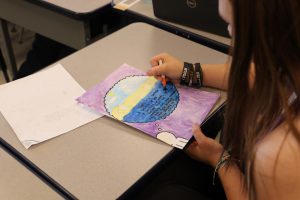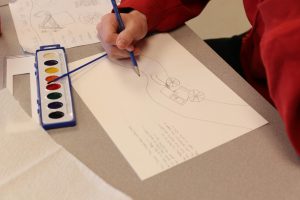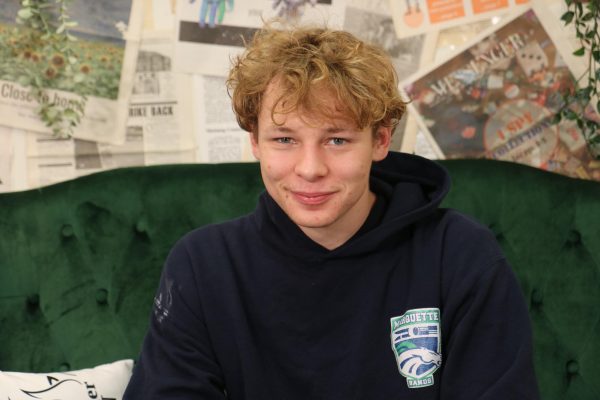
Emma Grzyb, junior, painted a deep sea inside a thought bubble to represent the never ending space of emptiness described by Emily Dickinson in her poem “There is a Solitude of Space.”
“I was thinking how she would be thinking as she was writing this poem,” Grzyb said. “That is how I drew it.”
Grzyb chose to represent her favorite Emily Dickinson poem in watercolor for a project on Emily Dickinson’s poems for 11 Language arts. She attempted to depict the emptiness and blankness Dickinson must have felt.
Grzyb said she can relate to the idea behind the poem and Emily’s feelings to some extent.
“After school I like to be by myself, in a space where I can just think and unwind from everything,” Grzyb said. “I do like being around people; however, Emily did not.”
Grzyb said she enjoys that the project is different from the usual activities done in class like reading poems and answering questions.
“I am more wanting to be involved in this project and try instead of just slopping words on a piece of paper,” Grzyb said.
Ace Lueken, junior, chose to do his watercolor interpretation on Dickinson’s poem “Because I could not stop for death.”

“It’s about how you can’t stop death, and it is going to come no matter what, and you can’t let that ruin your life,” Lueken said.
Lueken said the meaning behind his painting was a journey through life.
“I’m painting a carriage going across a setting sun going across a trail to show your journey through life as riding on the carriage,” Lueken said.
Lueken said he enjoys the artistic nature of the project and the fact that it is more hands-on and interactive.
Shelly Justin, language arts teacher, said she thought of the watercolor painting project because of how similar poetry and art are.
“Interpreting a poem is very much like interpreting a work of art,” Justin said. “That is really what you do when you go to an art museum and you look at art is you are interpreting it, and it is exactly the same thing for poetry.”
Justin said she thought the project would be more fun and interesting and enticing to students, especially because they had just finished a long research paper.
“I thought that this could make them more intimate with the poem and have a deeper understanding of a poem if they had to create some type of artwork with it,” Justin said.
Justin said she likes to focus on Dickenson because there were not many female poets during that time period.
“She is probably one of the most famous poets there is,” Justin said. “You definitely have to touch on her especially when you are talking about American literature.”
Dickinson was a transcendentalist poet, or someone who believes that nature, the mind and God are all interlinked, Justin said
Dickinson was a recluse and mostly kept to herself. A majority of her poetry wasn’t discovered until after her death and had about 1800 poems, Justin said.
“I’m kind of torn sometimes because it’s like we are reading her deepest most inner thoughts without her permission,” Justin said. “Her ideas are very forward thinking and the way she thinks about the world.”
Justin said her personal favorite Dickinson poem is “The Brain is Wider than the Sky” because of the idea that the mind is an infinite place, similar to the universe.
“That was the one that interested my students the most too. We had the most interesting discussions about that,” Justin said.




